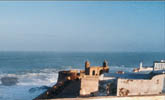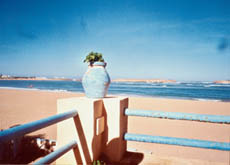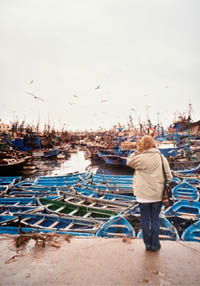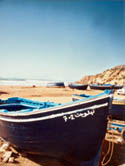Coastal Defence
Morocco's coastline
by Sarah Shuckburgh
Morocco's seaside is unfairly
overlooked, for beyond the ugly resort of Agadir are miles
of empty beaches and beautiful, unspoilt towns. Sarah
Shuckburgh reports.
 Most visitors to Morocco make for Marrakesh, Fez or the
Atlas Mountains. Few head to the coast, and those that do
tend to concentrate on Agadir or Casablanca. Agadir -
flattened by an earthquake in 1960, and rebuilt in ugly
concrete - is Morocco's main package-tour resort,
predominantly for holidaymakers who like nightclubs, burgers
and beer. Casablanca is Morocco's largest and most
cosmopolitan city - a financial, industrial and commercial
centre with multi-storey office blocks, boulevards jammed
with traffic, and businessmen and women in European dress. Most visitors to Morocco make for Marrakesh, Fez or the
Atlas Mountains. Few head to the coast, and those that do
tend to concentrate on Agadir or Casablanca. Agadir -
flattened by an earthquake in 1960, and rebuilt in ugly
concrete - is Morocco's main package-tour resort,
predominantly for holidaymakers who like nightclubs, burgers
and beer. Casablanca is Morocco's largest and most
cosmopolitan city - a financial, industrial and commercial
centre with multi-storey office blocks, boulevards jammed
with traffic, and businessmen and women in European dress.
But between these two crowded cities stretch 400 miles of
undisturbed Atlantic coast, with surf thundering onto empty
beaches, tranquil estuaries and lagoons teeming with birds -
and 300 days of sunshine every year.
Much of this coast is virgin territory, but dotted along it
are architectural reminders of a long and varied history,
with harbours and medieval walled medinas, Roman ruins, and
fortresses built by successive Hispano-Moorish, Portuguese
and French colonisers. This coast is also the homeland of
several tribes of Tashelhit-speaking Berbers, who were
farming this land long before Arabs arrived. These rural
Berbers have been little affected by colonialism or tourism
- their traditional lifestyles survive, and many have found
no need to learn French, or even Arabic.
Autumn and spring are perfect times to explore this
beautiful coast. The weather is sunny but not too hot and
the landscape is benign and pretty - there is also a good
chance of witnessing a local saint's day festival, or
moussem.
With one or two exceptions (see Morocco basics below),
Moroccan hotels are inexpensive, and you will rarely pay
more than £50 for a double room.
Agadir to Essaouira
North of Agadir, there are sheltered bays at Taghazoute and
Amesnaz, but elsewhere huge waves and a strong undertow make
for superb surfing - and perilous swimming. The road hugs
the shore as the Atlas Mountains loom up and finally meet
the ocean at Cap Rhir, the historic boundary between the
Ida-Outanane Berbers to the south, and the Haha Berbers to
the north.
The kingdom of Haha is perhaps the most dramatic part of the
coast - much of it inaccessible except on foot or camel. The
road twists through rugged hills of red earth, scarred by
flash floods. Sea mist rises in steep gorges, revealing
glimpses of deserted beach. Not much grows on these rocky
hillsides except argans - trees that are found nowhere else
and whose oil locals use for cooking, skin care and treating
infertility.
 Occasional tracks lead towards remote hamlets and fortified
Berber granaries, or agadirs. One turning winds down to a
crescent of fine, golden sand below Cap Tafelny headland.
The tiny hamlet has a grocery kiosk, a two-table cafe, and a
dozen blue wooden fishing boats, beached near a row of
dilapidated huts. Occasional tracks lead towards remote hamlets and fortified
Berber granaries, or agadirs. One turning winds down to a
crescent of fine, golden sand below Cap Tafelny headland.
The tiny hamlet has a grocery kiosk, a two-table cafe, and a
dozen blue wooden fishing boats, beached near a row of
dilapidated huts.
Tamanar and Smimou are workaday towns, with arcaded main
streets lined with cafes serving spicy harrira soup, and
fish, lamb or chicken stews cooked on smouldering charcoal
in blackened tagines. Weekly markets throng with men buying
and selling dates, olives, honey, bananas, argan oil, and
other produce displayed on the ground.
The men sip mint tea while their donkeys drink from shallow
oueds. Later the men trot their donkeys home, perched
sideways on bulging saddlebags. Others squeeze 10 or 12 at a
time into shared taxis, each one a rusty jalopy with
belching exhaust and creaking suspension, with sacks and
parcels protruding from the boot and tied to the roof.
This is one of the poorest areas of Morocco, with few
sources of income apart from subsistence farming on arid
land. A woman's place is at home or on the family plot of
land.
Fifteen miles before Essaouira, a turning leads to the
shrine of Sidi Kaouki, and another perfect surfing bay.
The Hotel des Cascades near Agadir is a peaceful place to
stay before embarking on the coastal drive. It is at
Immouzer des Ida Outanane, 30 miles inland, up a dramatic,
winding road through banana plantations (00212 4882 6016).
South of Essaouira, the Residence Le Kaouki has plain rooms
but good food (4478 3206).
Essaouira
If you only visit one place along this coast, choose
Essaouira. It is an enchanting fortified fishing port, built
by successive Berber, Portuguese and French colonisers on a
rocky promontory, almost at sea level. The harbour is a hive
of activity - veiled women sit on upturned buckets watching
as their menfolk unload their catch, mend nets, sort
fish-hooks, and tip cartloads of ice into grimy wooden
boats.
Locals in hooded cloaks and pointed slippers sit on their
haunches by the harbour wall, inspect rows of strangely
shaped, twitching fish displayed on the cobbles, or tuck
into seafood dishes, cooked to order on outdoor grills. Boat
builders hammer at curved wooden hulls, gulls squawk
overhead, and there is an all-pervading smell of fish.
 Inside the ramparts, you'll find beige and white-walled
houses with sky-blue paintwork. Local women waft down
covered alleys, mysteriously enveloped in haiks - white,
sheet-like shrouds that cover everything except their
sandals and surprisingly colourful socks. Artisans hammer
and carve in tiny, fragrant workshops. Local thuya wood
polishes up like walnut, and the inlaid tables, solitaire
sets, chess boards and tissue boxes have a golden, marbled
glow. Inside the ramparts, you'll find beige and white-walled
houses with sky-blue paintwork. Local women waft down
covered alleys, mysteriously enveloped in haiks - white,
sheet-like shrouds that cover everything except their
sandals and surprisingly colourful socks. Artisans hammer
and carve in tiny, fragrant workshops. Local thuya wood
polishes up like walnut, and the inlaid tables, solitaire
sets, chess boards and tissue boxes have a golden, marbled
glow.
In contrast to other Moroccan souks, there is no hard sell
here - a calm atmosphere of tolerance and respect prevails,
and this is reflected in the kaleidoscope of facial
features. Even the many stray dogs and cats seem to get on
well.
Outside the walls, a windy crescent of sand stretches south,
backed by a straggle of new hotels. Here you can ride camels
or horses, windsurf and sand-yacht, or watch impromptu games
of evening football. Out in the bay, the
Mogador islands are breeding grounds for a colony of the
rare Eleanora's falcon. At the far end of the beach, tucked
into the sand dunes across the Ksob river, is the Berber
village of Diabat, which became notorious in the 1960s after
a visit from Jimi Hendrix.
In the medina, Villa Maroc is a glamorous and comfortable
riad hotel, with sitting and eating areas around two
18th-century courtyards (book well in advance on 4447 6147).
For a longer stay, rent a furnished apartment overlooking
the ramparts (4447 5538). For comfort, choose Dar Mimosas
just outside Essaouira. Dotted about a mimosa-filled garden
are eight immaculate villas, painted in vivid shades of blue
and terracotta, and furnished with Moroccan art and antiques
(4447 5934).
Essaouira to Safi
The coast road linking Essaouira with Safi has only
recently been built, and its smooth, straight path through
the sparsely populated region of the Regrada Berbers makes
for stress-free driving. Jackals, wild boar and mountain fox
live in the limestone hills of the Jbel Hadid, which are
covered with the scrubby thuya trees used by local craftsmen
for marquetry and carving. Dry-stone walls surround tiny
boulder-strewn fields, where families, bent double, hack at
clods with wooden hoes. In spring, agave flowers stand 20
feet tall, and meadows gleam with marigolds. Beyond the
dunes is the endless arc of the ocean, with surf pounding
onto miles of empty windswept sand. Here and there a small
track leads from the main road to a village of roughly
thatched houses made of sun-baked mud and stone - with
strangely few ground-floor windows. Women appear in doorways
to douse their steps with buckets of water. Sea spray blows
on to a little minaret and groups of men loll against
turquoise fishing boats.
After the road crosses the Tensift river, there are hints of
comparative prosperity - a camel pulling a wooden plough,
women leading an ox or a horse on a rope, and, swaying along
the verge, a donkey cart, with a small boy sitting astride a
heap of greenery.
Safi
As you approach from the south, Safi (or Asfi) may seem
unappealing, with red slag heaps, railway sidings, chimneys
belching smoke, and an all-pervading stench of fish. Built
in a steep river valley, the town is a modern industrial
centre and fishing port, with one of the world's biggest
sardine fleets.
Don't be put off. Make your way through the soulless new
town to the old fortress - the "Castle on the Sea" - and
stroll through the crowded souk in the medieval medina to
the extraordinary hillside potteries just beyond the medina
walls. Here, burrowed out of the pinkish-red earth, networks
of dark tunnels and cramped caves house dozens of workshops.
A boy may volunteer to guide you through the stages of
production, each in a separate subterranean hovel too low to
stand in, where potters crouch on low stools, and Moroccan
music crackles from dusty radios. Nowhere in Morocco will
you find cheaper pottery, and it will be hard to leave Safi
without a brightly decorated piece.
For accommodation, your best bet is the slightly faded
Atlantide (4446 2160).
Safi to Oualidia
The ancient kingdom of the Doukkala Berbers is, if
possible, even more beautiful than the land of the Haha. The
road is again smooth and empty as it crosses stony plateaus
and gently undulating land, past sandhills and limestone
cliffs, beyond which waves thunder ceaselessly upon miles of
astonishingly empty sand, including the lovely Lalla Fatna
beach 10 miles from Safi. There are few houses, but smiling
children appear as if from nowhere at the side of the road
selling huge shells, or holding aloft a shiny fish.
Cap Beddouza lighthouse is visible from miles away, rising
from its eccentric green and white fortifications on a rocky
headland. Every day, at dawn and dusk, the keeper climbs to
the top of the lighthouse to draw a curtain round the lamp,
so that the fierce African sun cannot shine through the
prism and set fire to neighbouring houses. Nearby fields are
full of caves and potholes, leading to a network of largely
unexplored tunnels that locals claim stretch for miles.
For accommodation, the Auberge Cap el Beddouza (4462 5843)
has basic rooms. It's also a good spot for lunch or a mint
tea.
Oualidia
This place is beautiful and unspoilt. Running parallel to
the shore is a narrow spit of land that sends fans of spray
soaring as waves crash against it. The tide gushes in
through two gaps in this reef, but on the sheltered
shore-side is a calm, glittering lagoon, edged by a curve of
fine sand. Dolphins are a common sight. Fishermen like to
walk out along the spit, and stay there, cut off by the tide
as it rises, on occasion joined by flamingos. A hundred
yards inland is Oualidia's main street, full of locals going
about their daily lives. Beyond the reef, miles of untouched
beach stretch away into the distance, with waves rolling in
towards high sandhills.
Spend a few nights at the Hippocampe (2336 6108), where
simple but clean cabins are set in a terraced garden of
hibiscus and palms. After a lunch of fish soup and local
oysters, eaten on the terrace in the shade of a fig tree,
it's a few steps to the lagoon for a cooling swim.
Oualidia to El-Jadida
The coastal lagoons continue for many miles north of
Oualidia. There are glimpses of surf behind the sand bar,
but the road is less pretty than before. Small cafes,
sandwiched between road and sea, are tempting stops for a
meal and a swim. But the hillsides of argan trees have given
way to a sandy plain covered in castor oil shrubs - source
of the poison ricin. Farther on, the small village of
Moulay-Abdallah lies inside the ramparts of the 11th-century
holy city of Tit. Built to repel Vikings, Tit became an
important shrine of Islam, but was abandoned in the 16th
century. Today a handful of farmers and fishermen live here.
Le Relais (2334 5498), perched just above the crashing
waves, is a simple inn with a good seafood restaurant 15
miles south of El-Jadida. Ask for a room overlooking the
sea. Seven miles farther south, alongside the lagoon, is the
modest six-room Villa La Brise (2334 6917).
El-Jadida
El-Jadida is the capital of the Doukkala province, with a
dauntingly noisy, sprawling new town. Its urban beach front
is full of traffic and crowds in summer, and in winter
becomes a bleak promenade with wind-blown litter and
deserted cafes. But the walled medina is something else.
Built in 1502, it is arguably the best-preserved Portuguese
fortress town in Morocco, but few tourists explore the
rambling lanes and cobbled alleyways, which still retain
their Portuguese street names. A local boy may offer to show
you the wide ramparts, and will point out the disused
Catholic church and synagogue, and Morocco's only five-sided
minaret (which was once a lighthouse). Most memorable is the
Portuguese Cistern, a 16th-century vaulted cellar, used as
an arsenal and later as a fencing school, before becoming a
water tank. It was rediscovered only in 1916. The brick
floor is kept flooded with a few inches of water, and a
bright shaft of sunshine creates spectacular reflections.
Accommodation ranges from the luxurious Royal Golf Hotel,
overlooking both sea and golf course (2335 4141), but a more
charming choice is the dilapidated Palais Andalous, once the
residence of a local pasha, with elaborately tiled rooms
round an open courtyard. (2334 3745).
El-Jadida and Casablanca
Just north of El-Jadida is Azemmour, another little-visited
16th-century Portuguese fortress town, which provides a
unique opportunity to witness everyday life. Grizzled
shopkeepers peer out from their cupboard-sized shops and
adjust the bundles of vegetables heaped on upturned boxes.
Veiled women disappear down cobbled alleys of whitewashed
 houses and children stop kicking a stone to try out their
elementary French. houses and children stop kicking a stone to try out their
elementary French.
Beyond Azemmour, the wilderness of dunes gives way to
straggling groves of eucalyptus and pine, and then scrubby
farmland. The sea is nearby, but hidden from the coast road
by sandhills. The main road, farther inland, is probably the
better bet for this last stretch of coast through the
traditional region of the Chaouia Berbers.
Note that big-city Casablanca can come as a shock after the
quiet of the coast, so you might consider spending your last
night in El-Jadida - but allow plenty of time for navigating
the busy roads near Casablanca's airport.
First published by the Telegraph
İSarahShuckburgh |